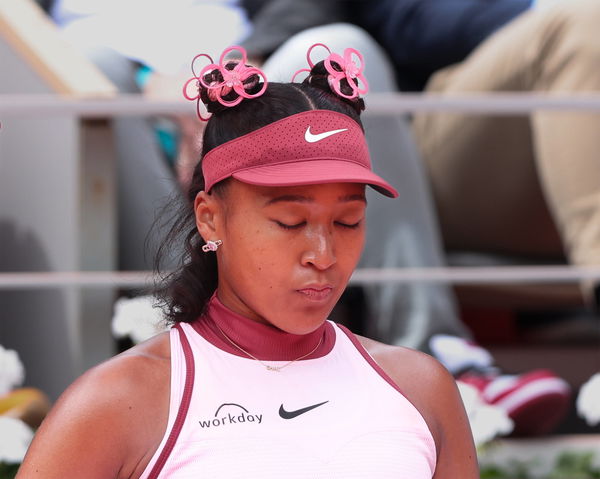
via Imago
Naomi Osaka Tennis – French Open 2025 – Roland Garros – Paris – – France – 26 May 2025. *** Naomi Osaka Tennis French Open 2025 Roland Garros Paris France 26 May 2025 Copyright: xJuergenxHasenkopfx

via Imago
Naomi Osaka Tennis – French Open 2025 – Roland Garros – Paris – – France – 26 May 2025. *** Naomi Osaka Tennis French Open 2025 Roland Garros Paris France 26 May 2025 Copyright: xJuergenxHasenkopfx
Coming into 2025 Naomi Osaka has been in a rebuilding phase and the US Open semifinal run marked one of her strongest performances in years. But for Osaka, success doesn’t only mean advancing deep in a Grand Slam by defeating champions like Coco Guaff in straight sets. It also shows up in less visible, more taxing ways: in the unexpected knock on her door from anti-doping testers.
Osaka took to social media to share what she’s been going through lately. A few days ago, taking to her Instagram stories, she had posted a photo of her arm with a bandage, writing: “When anti-doping comes 2 times in 5 days and gets you in the same arm each time 😭😭😭” And yesterday, having revaluated these frequent tests as a measure of how well she seems to doing on court, she posted on Threads: “You know you’re doing well when antidoping keeps showing up 💀😭😭😭”
But why the sudden uptick? Osaka’s semifinal run at the US Open and strong hard-court swing in August have thrust her back into the sport’s highest competitive tier. And under ITIA and WADA protocols, top-level players in the registered testing pool are subject to unannounced, out-of-competition testing, with priority on those performing well or re-entering the elite ranks. In practice, that can mean more visits from sample collectors during training blocks or downtime, especially after a player posts breakthrough results. On paper, it makes sense. But in reality, it’s more than an inconvenience.
ADVERTISEMENT
Article continues below this ad
She’s been tested twice in just five days since the US Open, both times in the same arm, leaving her bruised and frustrated. Earlier this year at Roland Garros, she even recounted being woken at 5 a.m. for an unannounced test where officials tried three times to find a vein, switching arms mid-draw. That kind of clustering, combined with disrupted sleep and lingering soreness, added to her openness about anxiety, postpartum recovery and the physical toll of her comeback season, makes the process far more intrusive even though she supports clean sport. But, Osaka isn’t the only one feeling singled out.
Earlier this season, American pro Taylor Townsend, also a mom on tour, thought she was getting a quiet Saturday morning with her 4-year-old son until anti-doping officials showed up. Taking to Instagram, she posted a picture of her arm patched with a bandage, the kind you get after a blood draw, and wrote “My sat morning 🤦🏾♀️😤🙃.” Serena Williams’ experience offers another layer.
Back in 2018, Serena Williams said she was being tested far more often than other players, already five times by mid-year, and questioned why it felt like she was being singled out. She stressed she wanted a clean sport but called for equal treatment, using the word “discrimination” to describe the imbalance.
However, for Osaka, beyond this suffering is still more dwelling on her loss to Anisimova. It hurt, given the fact that Osaka had shown immense improvement on the court after a long time. But guess what? The Japanese star has realized that she has a long way ahead. Seems like she was still somewhat satisfied with her campaign in New York.
ADVERTISEMENT
Article continues below this ad
Naomi Osaka speaks her heart out about US Open setback
While Naomi Osaka‘s entire 2025 season hasn’t gone the way she would have wanted it to be, the second half has been a game-changer. Last month, she managed to reach the final of a WTA 1000 event in a long time. Although she lost against teenage sensation Victoria Mboko, it was a huge accomplishment for the four-time major winner.
What’s your perspective on:
Is the constant doping scrutiny on Osaka a sign of her success, or an unfair burden?
Have an interesting take?
But the US Open proved that Osaka still has the fire within. Four years after she won her second trophy at Arthur Ashe in 2020, she made it to the semis for a third time. In doing so, she even beat World No.3 and two-time slam champion Coco Gauff in the fourth round.
ADVERTISEMENT
Article continues below this ad
During the post-match conference after losing to Anisimova, Osaka shared her unfiltered thoughts. Looking at the positive side of the outcome, she said, “I don’t feel sad. I just feel like I did the best that I could. It’s honestly kind of inspiring for me. It makes me want to train and try to get better.” Thanks to her stellar campaign this month, she has also achieved her best ranking in years.
From being No.23, Osaka is now under the top 15 (at 14 as of this writing). Currently, she is on the verge of breaking into the top 10 once again. It will be intriguing to see if she can make it happen before the end of the 2025 season.
ADVERTISEMENT
ADVERTISEMENT
ADVERTISEMENT
ADVERTISEMENT



Is the constant doping scrutiny on Osaka a sign of her success, or an unfair burden?